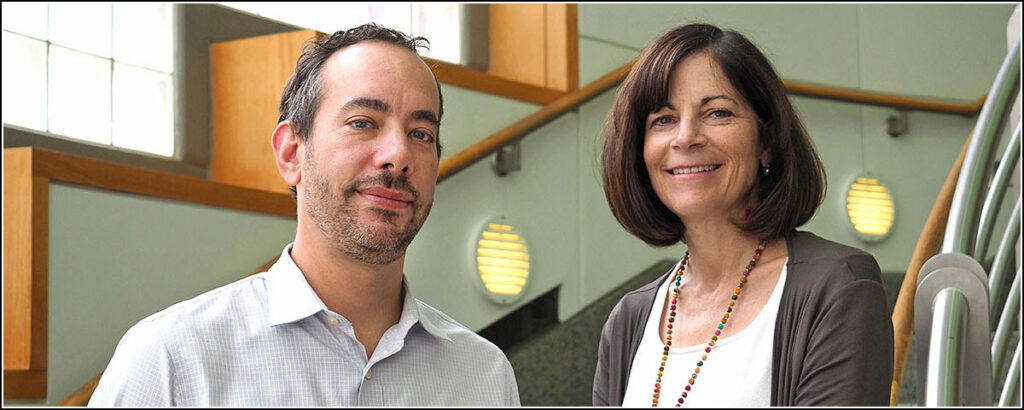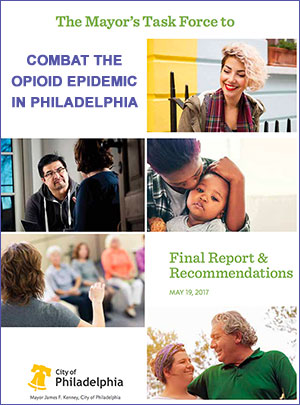Substance Use Disorder
News
Optimizing Heroin Users’ ‘Treatable Moments’ in The ER
Penn Physicians Discuss Philadelphia Opioid Task Force Report Recommendations

Penn Medicine emergency room physicians and LDI Senior Fellows Zachary Meisel and Jeanmarie Perrone participated in the Philadelphia Mayor’s “Task Force to Combat The Opioid Epidemic” project. They grapple with the medical issues posed by heroin addiction up close and personal every day. Click image for larger.
A grim insight of emergency room physicians who treat heroin patients is that the excruciating pain of drug withdrawal is often more powerful than a near-death overdose experience in motivating users to think seriously about kicking their habit.
“Near-death experiences are very impactful on families and loved ones but not always so impactful on the patient, whereas suffering from withdrawal is a really terrible feeling that seems to motivate people more,” said Jeanmarie Perrone, MD, Director of the Perelman School of Medicine’s Division of Medical Toxicology and an LDI Senior Fellow.
“Treatable moments”
Both conditions are recognized as potential “treatable moments” in which an ER patient has suddenly become more amenable to the idea of trying to extract himself or herself from a harrowing addiction. But, physicians like Perrone warn, that inclination for change passes quickly if the patient is not aptly assisted in turning the desire into action.
The potential to more effectively use these ER treatable moments in hospitals across the Philadelphia region is the subject of two of the most discussed recommendations — “warm handoffs” and “medication-assisted therapy” — in the new Task Force to Combat the Opioid Epidemic Report issued last week by Mayor James Kenney.
Launched in January in the face of an unprecedented and continuing rise in the citywide opioid mortality rate, the Task Force included 23 top city health, judicial and law enforcement officials along with executives from insurance companies, health systems and addiction recovery centers, supported by five subcommittees staffed by 140 largely academic experts in every area of the field. The project set a 90-day goal to establish the elements of a comprehensive plan for coordinating a citywide response to the public health crisis that is killing nearly 3 people a day, every day.
Outside the box
“We were encouraged to think outside the box and not just about what would was ‘realistic’ in terms of what might get done,” said University of Pennsylvania Hospital (HUP) emergency physician Zachary Meisel, MD, who was a member of the Task Force’s Public Education and Preventive Strategies subcommittee. “The idea was to envision how it would be to have all the resources and all the political capital that we needed. It was really refreshing to be given an opportunity to think from the perspective.” Meisel is also an Associate Professor at Penn’s Perelman School of Medicine, and an LDI Senior Fellow.
The HUP ER in which he works is one link in what might be thought of as the Maginot Line of citywide hospital emergency departments to which heroin users in medical trouble constantly muster. And while these departments are pivotal points in the effort to deal with the human carnage of opioid addiction, they are surprisingly limited in what they can actually do.
ER barriers
Currently, federal restrictions prohibiting addiction treatment in acute care hospitals, along with the lack of ER protocols, training and other logistical and administration infrastructure prevent ER doctors from doing much more than stabilizing opioid-using patients for a brief period before sending them back out to the drug-using community from which they came.
“It’s frustrating,” said Meisel. “I had two overdose patients today who came in and were revived by Narcan (Naloxone). Both were kind of interested in getting clean. If we had offered it to them, I think they would have taken it. But instead, we can only refer them to where they might go for treatment but that’s when they are particularly vulnerable because they’re on their own. The ER needs the tight connection that can route them into treatment quickly.”
That’s where the addition of “warm handoff” and “medication-assisted therapy” capabilities in an ER could make a difference, according to the Task Force findings.
“The ‘warm handoff’ concept has been popularized by Pennsylvania State Physician General Rachel Levine, MD, and others,” explained Perrone, who was also a Task Force subcommittee member. “The idea is that when any substance use patient comes into any facility in the city and is ready for treatment, we should be ready to accept them and rapidly facilitate their ‘treatable moment’.”
First phase of detox treatment
Heroin patients most often arrive at ERs in two ways — wheeled in as overdoses or as walk-ins seeking help for intolerable withdrawal pain. In the recommended Task Force system after those patient’s immediate issues are addressed, they could be given an addiction-treating medication like buprenorphine (Suboxone) that alleviates withdrawal symptoms and initiates the first phase of longer-term addiction treatment. Simultaneously, the patient could be engaged by an infrastructure of in-house navigators — specially trained social workers versed in managing the complexities of finding and assisting the patient in entering an appropriate inpatient or outpatient treatment program.
“The concept,” said Perrone, “is there is no closed door and that we can provide a ‘warm handoff’ to that patient when they’ve reached a treatable state of mind.”
Perrone herself is working to establish parts of that concept within the Penn Health System. She is leading a group in the writing of a protocol for the use of addiction treating medications in the ER and she has completed the special eight hour training course and acquired what is called an “X Waiver” from the Drug Enforcement Administration. The waiver authorizes her for in-hospital administration of buprenorphine and other addiction medications for new patients as soon as those drugs are added to the Health System’s pharmaceutical formulary. The Therapeutics and Pharmacy Committee is scheduled to discuss this issue in its July meeting.
Expanding drug authorizations
Some HUP residents have already taken the X Waiver course. “We also plan to prepare more of our residents and faculty to get involved and be able to give ER patients their first couple of stabilizing doses in the emergency department,” she said.
Perrone is also helping with a Penn Presbyterian Medical Center program that received a grant earlier in the year to develop a warm handoff-like system of navigators to assist ER patients seeking treatment for addiction.
“It’s a big challenge,” Perrone said, “for a patient to come into the ER seeking treatment to get a first dose of Suboxone and be handed off to a navigator because, along with everything else, the navigator has to be able to get that patient their next dose 24 hours a day, including weekends and holidays.”
Centralized database of treatment programs
“Another of the challenges,” pointed out Meisel, “is getting a centralized method for matching open slots in evidence-based detox programs with patients. Right now, it’s a game of calling around and make-do research on who has slots where. We need a one-stop clearinghouse kind of resource — it could be a phone number, a website, an app — where you can SEE what’s available right NOW in terms of treatment facilities where we can get the patient in without delays.”
Meisel, who is also a primary investigator in the NIH-funded Center for Health Economics of Treatment Interventions for Substance Use Disorder, HCV and HIV (CHERISH), said he was optimistic that some of the Task Force Report’s recommendations that have drawn little interest in the past are now getting such serious consideration.
“The crisis has reached such a fevered pitch and is impacting so many people from all different walks of life and political persuasions that it has opened policy windows quite wide, more so than I’ve seen with any other health care issues I’ve ever been involved with,” Meisel said. “We’re now in a public health situation that demands new sorts of answers and approaches and that was pretty much what the Task Force was determined to explore.”
~ ~ ~
Hoag Levins is Editor of Digital Publications at the University of Pennsylvania’s Leonard Davis Institute of Health Economics (LDI) and a former reporter and editor at newspapers and magazines in Philadelphia, New York and Washington, D.C.
